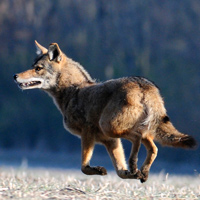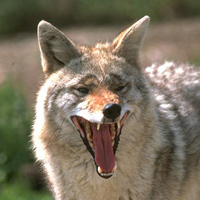
Coyotes (Canis latrans) are native to Indiana and were often called “prairie wolves.” Before the European settlement of Indiana, coyotes were primarily restricted to prairie regions of the state. Today, coyotes are found throughout Indiana, including urban areas.
Similar species
General characteristics
- The coyote closely resembles a German shepherd dog in height and shape but it carries its tail below the level of its back instead of curved upward and is generally half the weight of a German shepherd.
- Coyotes have a long slender snout and large, pointed ears.
- The upper body is a grizzled gray or buff, with a reddish-brown or gray muzzle and legs. The belly is white, cream-colored, or reddish yellow.
- The coyote has a bushy tail, which it carries below the level of its back.
- Coyotes average 25 pounds (ranging from 20 to 50 pounds), and they measure 40 to 50 inches long from nose to tail tip.
- Coyotes are elusive and normally avoid humans.
- They can be active day or night but are typically most active at dawn and dusk.
- The coyote communicates by barking, yipping, and howling.
Distribution and abundance

Coyotes are present in all sections of the state. There are records of coyotes in Indiana as early as 1816, though the species likely inhabited Indiana well before that time. Bounties on coyotes were in place in Indiana from at least 1849 through the late 1960s. Despite this persecution by early European settlers and later residents, coyotes persisted in Indiana. Historically, coyote populations were limited in range to the prairie regions of the state, and expansion may have partially been limited because wolves suppress coyote populations. However, with the eradication of wolves and conversion of habitat to farmland, coyotes have expanded and adapted to new habitats. Statewide coyote abundance slowly increased as coyotes continued to expand into previously unoccupied habitat. Today, coyotes occupy all of Indiana, no matter the habitat type or amount of development.
Reproduction
Coyotes may pair for life. They mate in February, and a litter with an average of four to six pups is born in a den in April. Dens may be located in a bank, rock outcropping, cave, or an enlarged woodchuck or rabbit burrow. Males help raise the pups and provide the female with food when pups are very young. Pups begin playing at the entrance of their den at 3-to-4 weeks old, and by 10 weeks they may leave the den completely. Pups learn to hunt during the fall and generally disperse before they turn 1 year old. Occasionally, a female yearling or two may stick around another year and help raise the next year’s pups.
Food habits
- Coyotes are opportunistic foragers that will consume anything of nutritional value.
- Coyotes primarily feed on small mammals, rabbits, and squirrels, even in urban environments. But they will not turn down an easy meal, nor will they pass up a free meal from human-provided food sources.
- They will scavenge exposed garbage or other refuse, and may even kill and consume house cats and small dogs.
- Besides small mammals, rabbits, and squirrels, coyotes may also eat fruit, insects, poultry, livestock, deer (especially fawns and road-killed deer), songbirds, and sometimes game birds.
Viewing Tips
Coyotes are elusive and difficult to view, but occasionally they are spotted foraging for mice in fields. Scanning fallow or recently harvested fields from Indiana’s interstate roads can be a surprisingly successful way to occasionally spot a coyote, as can slow drives on country roads in late fall and winter. Just as objects in mirrors are closer than they appear, remember that a fluffy coyote may appear larger than its true size, especially if it's standing in an empty field. Remember that Indiana doesn't have resident wolf populations, so it is highly unlikely you will see one.
Other than occasional daytime feeding expeditions, coyotes are mostly active at night. Instead of seeing coyotes, many people hear them, with their distinctive combination of chattering barks and howls. Because of their territorial nature, coyotes will also respond to calls and howls. Try to stop at a parking lot on a late summer evening at a property like Blue Grass Fish & Wildlife Area or LaSalle Fish & Wildlife Area do your best impression of a coyote and see if you hear a response. Keep in mind that you can’t tell group size after three coyotes start calling, so be careful not to convince yourself there’s dozens answering your call.
Management and control
Hunting and trapping are important components of managing coyotes in Indiana. However, not all coyotes are problem coyotes. Many coyotes live around people, pets, and livestock and never have negative interactions with them. When coyotes become habituated to people, problems can occur, and those animals may need to be removed. Similarly, when coyotes begin to prey upon livestock, those animals may need to be removed to stop the damage from occurring. Removing coyotes not causing problems around livestock can encourage new coyotes to move in which may cause damage.
People’s behavior is usually a key component in habituation occurring, so it’s important for people to do their best to discourage coyotes whenever possible.
Coyote prevention techniques
- Feed pets indoors when possible; pick up leftovers if feeding outdoors; and store pet and livestock feed where it’s inaccessible to wildlife.
- Eliminate water bowls and other artificial water sources (if possible).
- Position bird feeders in a location that is less likely to attract small animals or bring the feeders in at night (to keep coyotes from feeding on the bird food or the other animals). Take down bird feeders if issues are occurring.
- Do not discard edible garbage where coyotes can get to it. Secure garbage containers.
- Trim and clean shrubbery near ground level to reduce hiding cover for coyotes or their prey.
- Always keep pets leashed and, if kept outside, provide secure nighttime housing for them. Any outdoor pet or poultry runs should have a top to make them more secure and the fencing should be buried in the ground to prevent digging under the fence.
- If you start seeing coyotes around your home, discourage them by shouting, making loud noises, shaking a container of coins, using an air horn or whistle, spraying them with a hose, or throwing rocks or tennis balls but NEVER corner a coyote – always give the coyote a free escape route.
Farmers with livestock can take additional precautions
- Use net-wire or electric fencing to keep coyotes away from livestock.
- Shorten the length of calving or lambing seasons.
- Confine livestock in a coyote-proof corral at night.
- Use lights above corral.
- Use strobe lights and sirens to scare away coyotes.
- Remove dead livestock promptly so coyotes won’t be able to scavenge.
- Use guard animals, such as dogs, donkeys, and llamas to protect livestock.
Landowners may take coyotes year-round on their private property by trapping or shooting without possessing a wild animal control permit from the DNR and without having a hunting or trapping license. Additionally, a landowner does not need to possess a wild animal control permit from DNR to give another individual written permission to shoot or trap coyotes on the landowner’s property. However, any person taking coyotes on someone else’s property must have a valid hunting or trapping license and, if the take happens outside the regulated coyote season, have written permission from the landowner. Please note that any firearm, archery, or air rifle equipment used for coyote removal may be used only in accordance with local ordinances.
Individuals may also get help with coyote conflicts by contracting a wildlife control operator.
